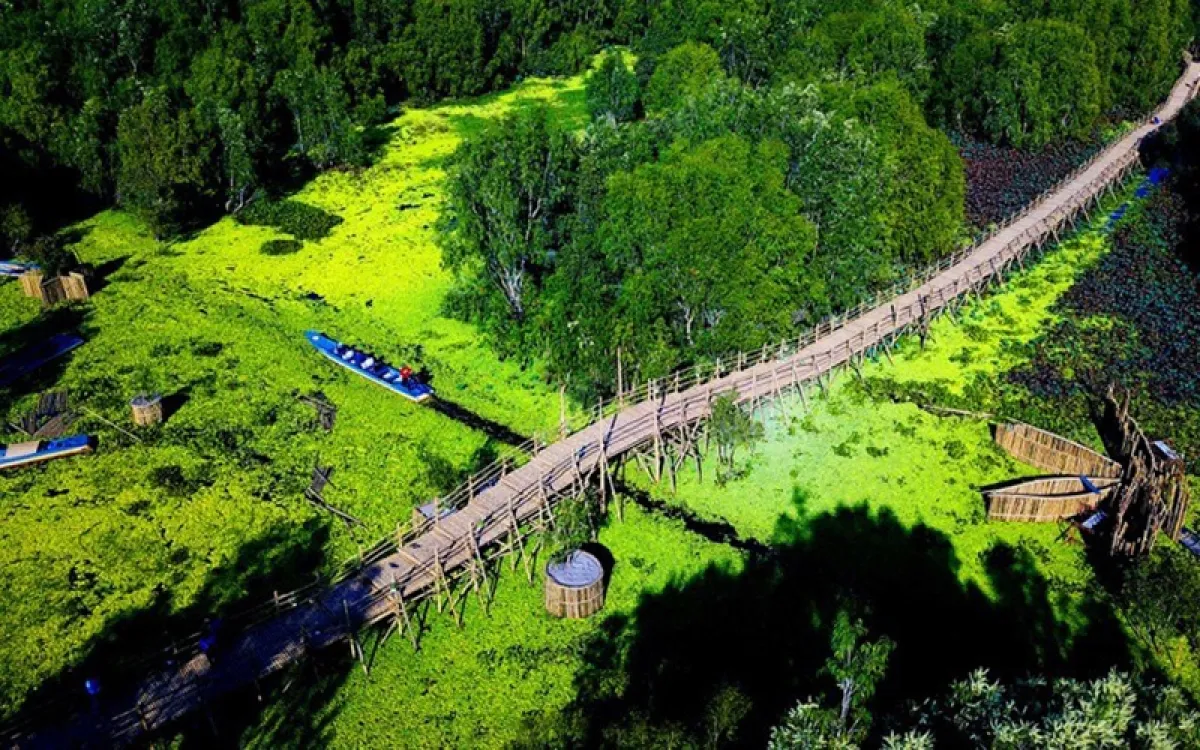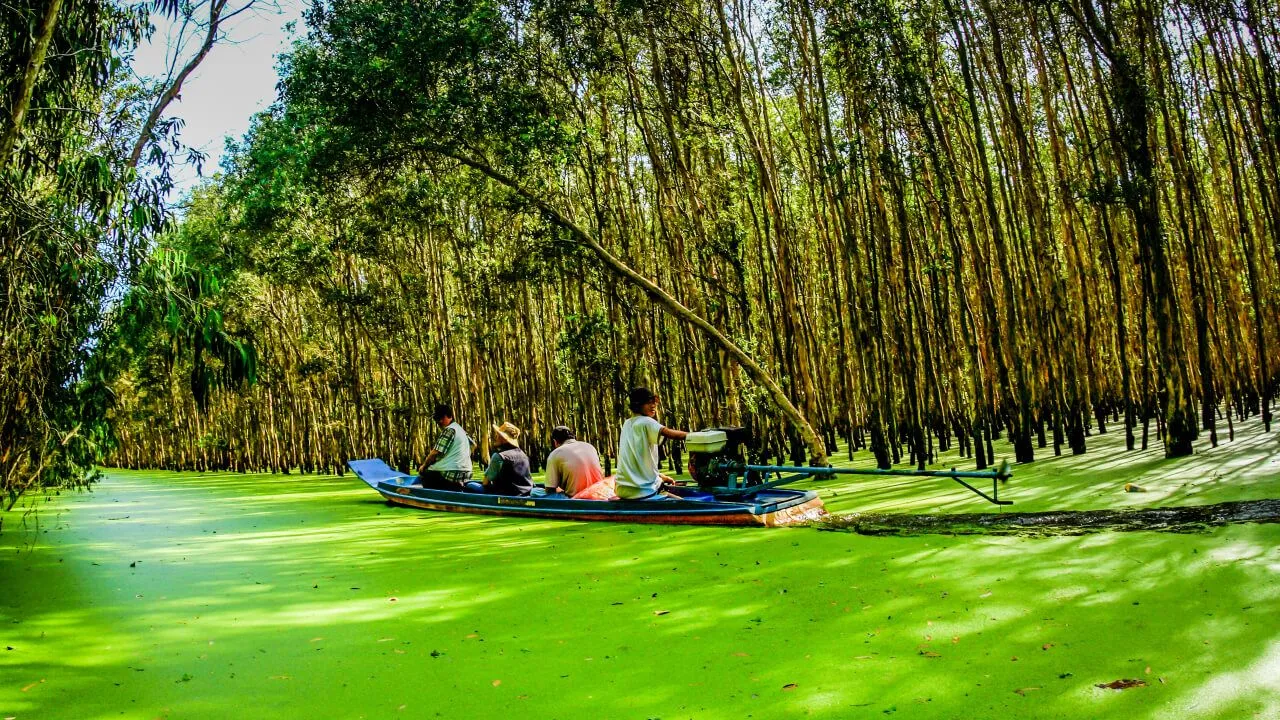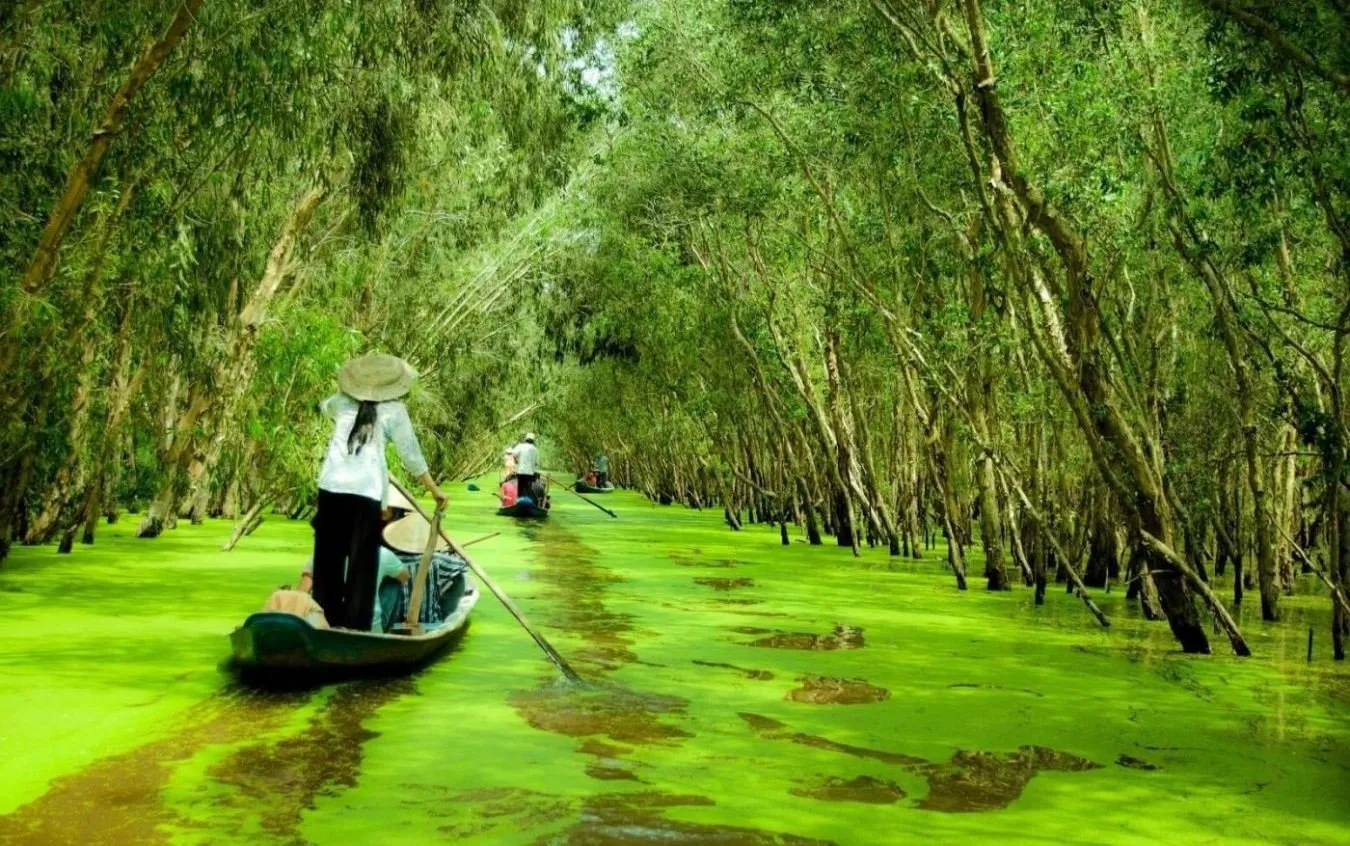An Giang’s flooding season has long been an iconic symbol of the Mekong Delta, a unique natural spectacle that captivates visitors. And when it comes to An Giang during this season, Trà Sư cajuput forest is a must-visit. This renowned ecological destination, dubbed the “green lung” of the Seven Mountains region, blends pristine beauty and richness, promising unforgettable experiences.
Where is Trà Sư Cajuput Forest? How to Get There?
Trà Sư cajuput forest is located in Văn Giáo commune, Tịnh Biên district, An Giang province. It’s approximately 30km from Châu Đốc city and 65km from Long Xuyên city. This area was once a alum-contaminated swamp, but thanks to land reclamation efforts and irrigation systems, Trà Sư has transformed into a top ecological tourist destination in An Giang, attracting a large number of domestic and international visitors.

The name “Trà Sư” has an interesting meaning. According to the most popular theory, “Trà” comes from the Khmer word “Tà” (grandfather), while “Sư” in Sino-Vietnamese means monk or teacher. Therefore, Trà Sư can be understood as “Grandfather Monk,” a name that evokes tranquility and sacredness for the forest.
Why Explore Trà Sư Cajuput Forest During the Flooding Season?
The flooding season (from September to November) is the best time to explore Trà Sư cajuput forest. At this time, the entire forest is cloaked in a lush green, full of vitality. The vast water surface reflects the trees, creating a magical and poetic space.
For the best experience, you should visit Trà Sư in the early morning (7:00 – 9:00 AM) to watch the sunrise and listen to the birds singing. Alternatively, you can come in the late afternoon (5:00 – 6:00 PM) to admire the beautiful sunset and watch flocks of birds returning to their nests.

The flooding season is also the season for Mekong Delta cuisine. When you come to Trà Sư, you will have the opportunity to enjoy specialties such as hotpot with sesbania sesban and linh fish, crispy fried linh fish, braised linh fish, steamed field crab claws, dried snakehead fish, and more.
Directions to Trà Sư Cajuput Forest
There are several ways to get to Trà Sư cajuput forest.
-
Bus: From Ho Chi Minh City, you can go to the Western Bus Station and buy a bus ticket to Long Xuyên or Châu Đốc. Ticket prices range from 150,000 – 300,000 VND/trip. Reputable bus companies you can consider are Phương Trang, Hùng Cường, Thảo Nguyên, Trọng Tín Limousine.
-
Motorbike/Car (Self-driving):
- From Ho Chi Minh City: Take the Trung Lương expressway to Tiền Giang, then follow National Highway 1A, cross Mỹ Thuận bridge, turn right towards Sa Đéc, go straight on National Highway 30 across Vàm Cống bridge, and follow National Highway 91 to Long Xuyên.
- From Châu Đốc: Follow Tân Lộ Kiều Lương street to National Highway 91, cross Trà Sư bridge, and go along the Trà Sư canal for a few kilometers to reach Trà Sư cajuput forest.
- From Long Xuyên: Follow National Highway 91 towards Châu Đốc, then follow the directions as above.

Discovering the Unique Beauty of Trà Sư Cajuput Forest in the Flooding Season
Trà Sư cajuput forest is not just a simple ecological tourist destination, but also a fascinating journey of nature discovery. Stepping into the cajuput forest, you will feel the peace, relaxation, and unspoiled beauty of the Mekong Delta.
The exploration begins at the boat dock with its unique architecture. Here, you can buy tickets and rent a “tắc ráng” (motorboat) to start your tour.
Sitting on the “tắc ráng,” weaving through small canals, you will admire the lush green cajuput trees, the green water fern carpets, and flocks of storks and birds flying in the sky. You may also encounter locals harvesting honey from cajuput flowers.

After about 3km, the “tắc ráng” will take you to the forest’s landscape protection area. Here, you can get off the boat and walk on a small path, exploring deeper into the cajuput forest.
Continuing the journey by paddle boat, you will immerse yourself in the tranquil space of the cajuput forest, admiring the vibrant yellow sesbania flowers, rare bird species, and enjoying the slow pace of rural life.
Another interesting experience is renting a bicycle to explore the cajuput forest. You can cycle on small paths, breathe in the fresh air, and admire the surrounding scenery.
Don’t forget to check-in at the “thousand-step bamboo bridge,” a unique structure made entirely of bamboo and recognized by Guinness Vietnam as the “Longest bamboo bridge in Vietnam.”
What to Eat at Trà Sư Cajuput Forest?
When you come to Trà Sư cajuput forest, you not only get to admire the beautiful scenery but also enjoy the culinary specialties of the Mekong Delta. In the restaurant area, you can find many delicious dishes such as eel hotpot, snake hotpot, frog hotpot, chicken hotpot, roasted quail, grilled chicken, grilled frog, and more. Prices here are quite affordable, ranging from only 100,000 – 200,000 VND per dish. In particular, grilled snakehead fish (100,000 VND/fish) and field crab hotpot (200,000 VND/hotpot) are dishes you should not miss.

Trà Sư cajuput forest during the flooding season is a great destination for those who want to explore the unspoiled natural beauty and experience the unique culinary culture of the Mekong Delta. Come and feel the charm of An Giang’s “green lung”!
Conclusion
Exploring Trà Sư cajuput forest in the flooding season is not just a trip, but also a journey back to nature, to the traditional cultural values of the Mekong Delta. Coming to Trà Sư, you will not only admire the pristine, majestic beauty of the cajuput forest, but also enjoy the flavorful local specialties. Plan your trip today to enjoy memorable moments at the “green lung” of An Giang! Are you ready to discover Trà Sư in the flooding season?